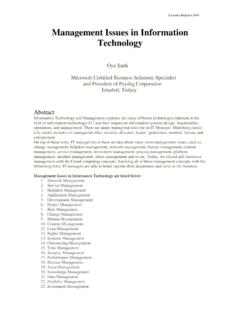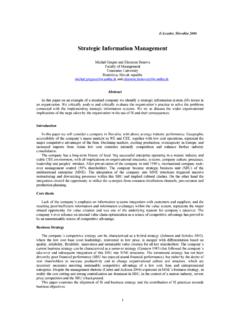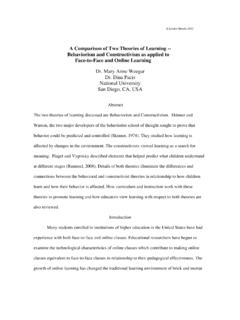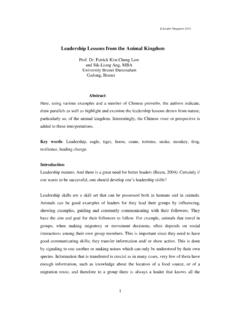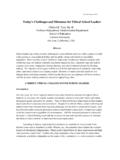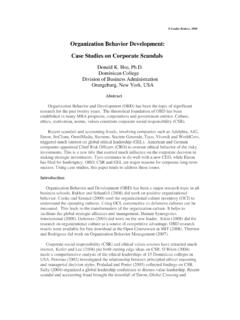Transcription of COMPETITIVE STRATEGY AND COMPETITIVE …
1 E-Leader, Slovakia 2006 COMPETITIVE STRATEGY AND COMPETITIVE ADVANTAGES OF SMALL AND MIDSIZED MANUFACTURING ENTERPRISES IN SLOVAKIA Emilia Papulova University of Economics Bratislava, Slovak Republic Zuzana Papulova Comenius University Bratislava, Slovak Republic Abstract: In order to be successful, organizations must be strategically aware. The need for all managers is to by able to think strategically. Decisions by managers have a strategic impact and contribute to strategic change. Strategic management is a highly important element of organizational success. Strategic success requires a clear understanding of the needs of the market, and the satisfaction of targeted customers more effectively and more profitably than by competitors.
2 Real COMPETITIVE advantage implies companies are able to satisfy customer needs more effectively than their competitors. It is achieved if and when real value is added for customers. Small and midsized enterprises which understand their customers can create COMPETITIVE advantage and so benefit from lower prices and loyalty of customers. Higher capacity utilization can then help to reduce costs. Thinking Strategically Today s organizations have to deal with dynamic and uncertain environments. In order to be successful, organizations must be strategically aware. They must understand how changes in their COMPETITIVE environment are unfolding. They should actively look for opportunities to exploit their strategic abilities, adapt and seek improvements in every area of the business, building on awareness and understanding of current strategies and successes.
3 Organizations must be able to act quickly in response to opportunities and barriers. Managers operating in organizations perform a number of activities including planning and organizing the work of their subordinates, motivating them, controlling what happens and evaluating results. Decisions by managers have a strategic impact and contribute to strategic change. The organization is shown as one of a number of competitors in an industry; and to a greater or lesser degree these competitors will be affected by the decisions, COMPETITIVE strategies and innovation of the others. These inter-dependencies are crucial and consequently strategic decisions should always involve some assessment of their impact on other companies, and their likely reaction. To succeed long term, organizations must compete effectively and out-perform their rivals in a dynamic environment.
4 To accomplish this they must find suitable ways for creating and adding value for their customers. Strategic management is a highly important element of organizational success. The need to know what the business is about, what it is trying to achieve and which way it is headed, is a very basic requirement determining the effectiveness of every member s contribution. Every successful entrepreneur has this business self-awareness and every successful business seems to have this clarity of vision, even though it does not arise from a formal planning process. [6] Managers who made long-range plans generally assumed that better times lay ahead. Future plans were merely extensions of where the organization had been in the past. But a number of environmental shocks undermined this approach to strategic planning: rapid technological developments, the maturing or stagnation of certain markets, increased international competition.
5 These changes forced managers to develop a systematic means of analyzing the environment, assessing their organization s strengths and weaknesses, and identifying opportunities for COMPETITIVE advantage.[7] E-Leader, Slovakia 2006 In the case of some small businesses external forces can dictate whether the business stays solvent or not. A major problem for many small businesses concerns the management of cash flow. To succeed, a business must have clearly defined objectives and fully developed STRATEGY for achieving them. In short, what is needed is a business plan. A business plan shows the purpose of the business and what it intends to accomplish. A good business plan helps to give form and substance to an entrepreneurial vision, providing a mechanism that enables owners, managers and workers alike to function effectively.
6 The COMPETITIVE Environment Whilst it is essential for all managers to have some insight into how their organization is affected by the environment, it is also desirable for them to consider how some of the environmental forces might be influenced and managed to gain benefits for the organization. This is less possible generally in the case of small businesses as they are relatively less powerful. However, small companies should examine their environment for opportunities and threats in order to establish where they can gain COMPETITIVE advantage and where their resources might most usefully be concentrated.[10] Thinking strategically requires an awareness of alternative strategic purposes and objectives and the ability to recognize critically different environments. In addition it requires the ability to diagnose an organization in terms of various critical characteristics and to be able to shape those characteristics so that the organization is best fitted to its environment in order to achieve its strategic purposes and objectives.
7 A complex and dynamic modern environment is inevitably difficult to forecast, the inherent uncertainties can make it highly unpredictable and potentially chaotic. Individual managers would develop their environmental and strategic awareness through experience and perception, and by thinking about their observations and experiences. It is particularly important to assess the significance of what happens and what can be observed to be happening. However, in considering future strategic changes there will be an additional need to supplies, customers, competitors, demand, technology, government legislation and so on. Managers who are encouraged to think about future changes, to ask questions and to query assumptions will increase their insight and awareness and this should help decision making.[10] Effective strategic management involves more than just a few easy steps.
8 It requires managers to thing strategically, to develop the ability to see things in motion, and to make sense out of a cloudy and uncertain future by seeing the interdependency of key factors. This ability requires more than a passing awareness of significant social, political, legal, economic and technological trends. Managers who think strategically are able to envision their organizations in the context of world trends and events and to spot important interdependencies. They focus on how their organization should act and react to emerging opportunities and barriers. For any organization certain environmental influences will constitute powerful forces which affect decision making significantly. For some manufacturing and service businesses the most powerful force will be customers; for others it may be competition.
9 [10] According to Ansoff, the extent to which the environment is changeable or turbulent depends on six factors: changeability of the market environment, speed of change, intensity of competition, fertility of technology, discrimination by customers, and pressures from governments and influence groups. He suggests that the more turbulent the environment is, the more aggressive the firm must be in terms of COMPETITIVE strategies and entrepreneurialism or change orientation if it is to succeed.[10] The COMPETITIVE environment is affected by market structure and profitability; the intensity of COMPETITIVE rivalry and the degree of differentiation; market growth; the stage in the life of the products or services in question and the frequency of new product launches; capital intensity; and economies of scale.
10 It is important for managers to appreciate where the greatest opportunities and threats lie at any time and focus attention on those areas which are currently affecting the organization and which require strategic attention. Strategic Approach STRATEGY is not about planning, but about thinking and doing. It is not a technique, but a way of managing the business according to a strategic understanding and perspective.[6] Strategic management is concerned with understanding, choosing and implementing the STRATEGY that an organization follows. Managers should be aware of the issues which must be addressed if changes in STRATEGY are to be formulated and implemented effectively. In addition, they should be aware of the managerial and behavioral processes which take place within organizations in order that they can understand how changes actually come about.


